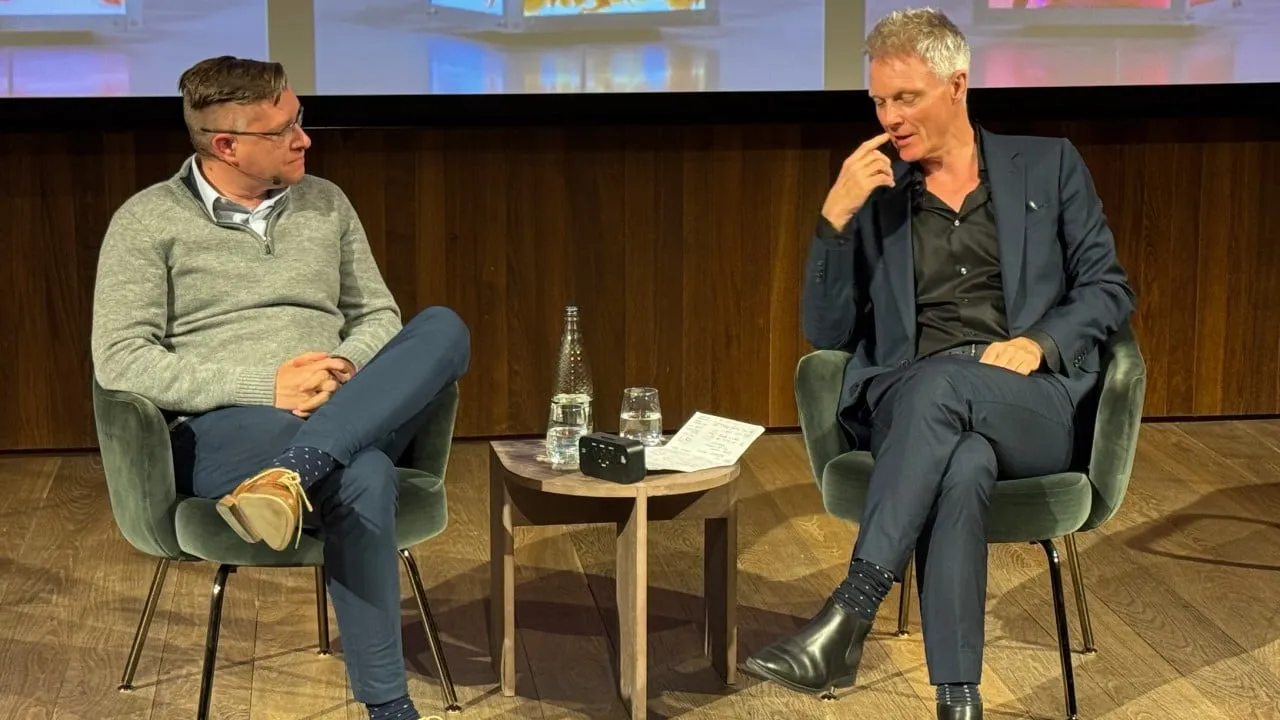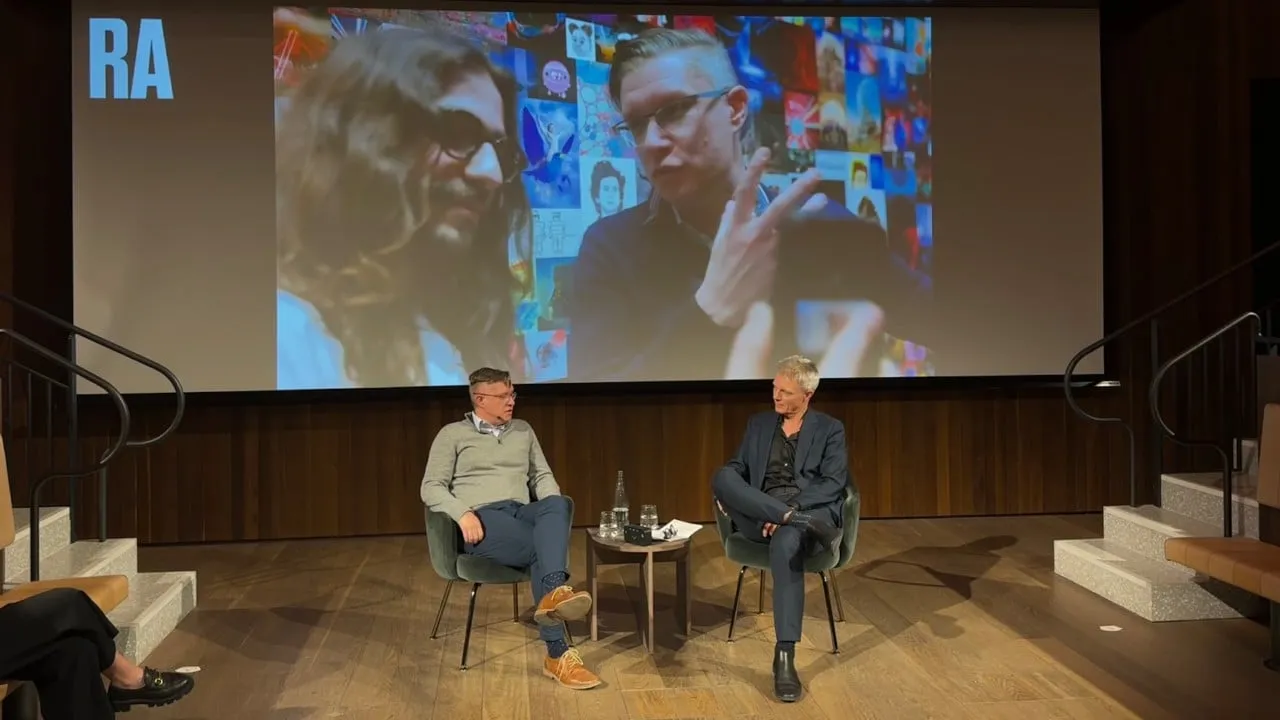Digital artist Mike “Beeple” Winkelmann broke records in 2021 with the sale of his NFT artwork “Everydays: The First 5,000 Days,” which sold for $69.3 million at auction.
Since then the fervor around NFTs has cooled substantially, with trading volumes plunging by over 90%.

Mike Winkelmann, aka Beeple, and Tim Marlow OBE. Image: Decrypt
Speaking last week at an on-stage interview with the chief executive of the Design Museum, Tim Marlow OBE, at London’s Royal Academy of Arts, Beeple reflected, “It’s crazy to me to think about those times, because NFTs have been hated for so much longer than they were loved.”
“There was this very brief window where people were like, ‘Yes, this is the future,’” he said. “And then it went right back to like, ‘Oh, you fucking piece of shit, don’t put that evil on me.’”
“We lost a lot of people,” Beeple added, “but those people were never in it for the art, and I could see that immediately.”
He said that at the time of the “Everydays” sale, he knew the market was “100%” a bubble.
“I was making digital art for 20 years before that, and I saw people buying shit,” he said. “It’s like, ‘There is no fucking way that is going to hold value, that is absolute crap. And it just will not last, you will realize that is correct.”
While acknowledging that the NFT market “was going to come back down to Earth” and that speculators have “moved on,” Beeple noted that “there is still very much a lot of enthusiasm around this stuff.”
He pointed to multi-million-dollar sales of CryptoPunks earlier this year, saying, “It’s crazy to me how sort of normalized it’s been,” and wondering at the fact that “It wasn’t news at all. I mean, like, a massive sale, still, in the art world.”
Beeple’s own art sales are more tightly controlled than at the height of the NFT boom, he said, explaining that “we’re thinking about supply and demand and not putting out too much work.” He added that his team now focuses on “private sales to people who are acting as the role of the gallery,” to ensure purchasers are “serious collectors” who aren’t going to simply “flip this.”
At the same time, he said, the secondary market for his work is permissionless. “People can just go on websites and buy something right now, put in your MetaMask, and there you go,” he said.
A fractured market of authenticity
Beeple also pointed to a “segmentation” in the NFT market, with some projects having lost sight of the tech’s true vision.
“This technology, a lot of the stuff that it was used for, and that people it became associated with, wasn’t really kind of like art,” he said, pointing to the Bored Ape Yacht Club NFT collection. “Even they would say that this is on the collectible side, and they’re trying to build a social club, and this and that,” he said, arguing that different use cases for NFTs had become “conflated.”
NFT technology, he said, is “agnostic,” likening it to a web page. “A web page can be many different things, and an NFT is a way to prove virtual ownership of many different things,” he explained.

Mike Winkelmann, aka Beeple, and Tim Marlow OBE. Image: Decrypt
“I personally think in the future, every painting will have an NFT as the certificate of authenticity,” he said, adding, “It’s just a better way than a piece of paper to be able to prove ownership of these pieces, be able to prove the provenance, be able to prove the exhibition.” Widespread adoption of NFTs to authenticate physical art, he added, requires an agreed-upon “standard for that NFT.”
Dynamic NFT art
While the NFT market has since cooled, there remains a core of “passionate” NFT enthusiasts who “understand this technology and understand it as a medium to express artistic ideas in a way that just was not possible before,” Beeple said.
The technology has enabled him to create dynamic artworks where changes to the piece are recorded on the blockchain. With his most recent works, Beeple has branched out from the strictly digital space where he made his name, with two physical pieces—”Human One” and “The Tree of Knowledge.”
Both consist of four video screens arranged in a rectangular pillar, displaying a dynamic digital artwork—a striding figure in the case of “Human One” and a tree entwined with industrial elements in “The Tree of Knowledge.”
The dynamic changes of “Human One” are made by Beeple himself, who alters the landscape through which the titular figure strides.
“When the piece sold at Christie’s, he was moving through these sort of surreal landscapes; and then at the show at Costello, he was walking through a Ukrainian war landscape,” he explained. “The war hadn’t even started when the person bought the piece, so they couldn’t have possibly known that that would be a commentary on the war, just six months later.”
The Tree of Knowledge, meanwhile, pulls in real-time data from feeds including news channels, stock and crypto tickers, environmental data, and social media, with viewers able to dial the proportion of “signal,” meaning order, to “noise,” meaning chaos.
A further complication is that the viewer has the option to “choose violence,” which triggers a 10-minute animated sequence in which the tree is destroyed. “Each time you press that, it really is recorded on the blockchain,” Beeple explained, adding, “There’s only 666 times where you can press that button before it permanently destroys the work.”
Access to the button is controlled by a key held by the artwork’s owner, Beeple explained. “It’s an analogy to the fact that certain people do have the ability to press that button,” he said. “We don’t.” He added that the fixed limit gives the artwork “weight; it has consequences.”
Museums struggle with the idea of dynamic artwork, he said. “Even just the idea that Human One changes,” he said, “I talk to people at museums, and they’re, like, ‘Wait, I don’t know what it’s going to say?’” He added that museums and collectors will eventually come to embrace the “new capabilities” of dynamic digital art.
“There will be a trust in the artist to continue to say new things through digital art, and change it in ways that continue to bring new beauty and challenge the owner,” he said. “Time can be this component of it, in a way that physical art just inherently can’t be, because it’s a state frozen in time. This can be more akin to a conversation.”
Edited by Sebastian Sinclair







Leave a Reply